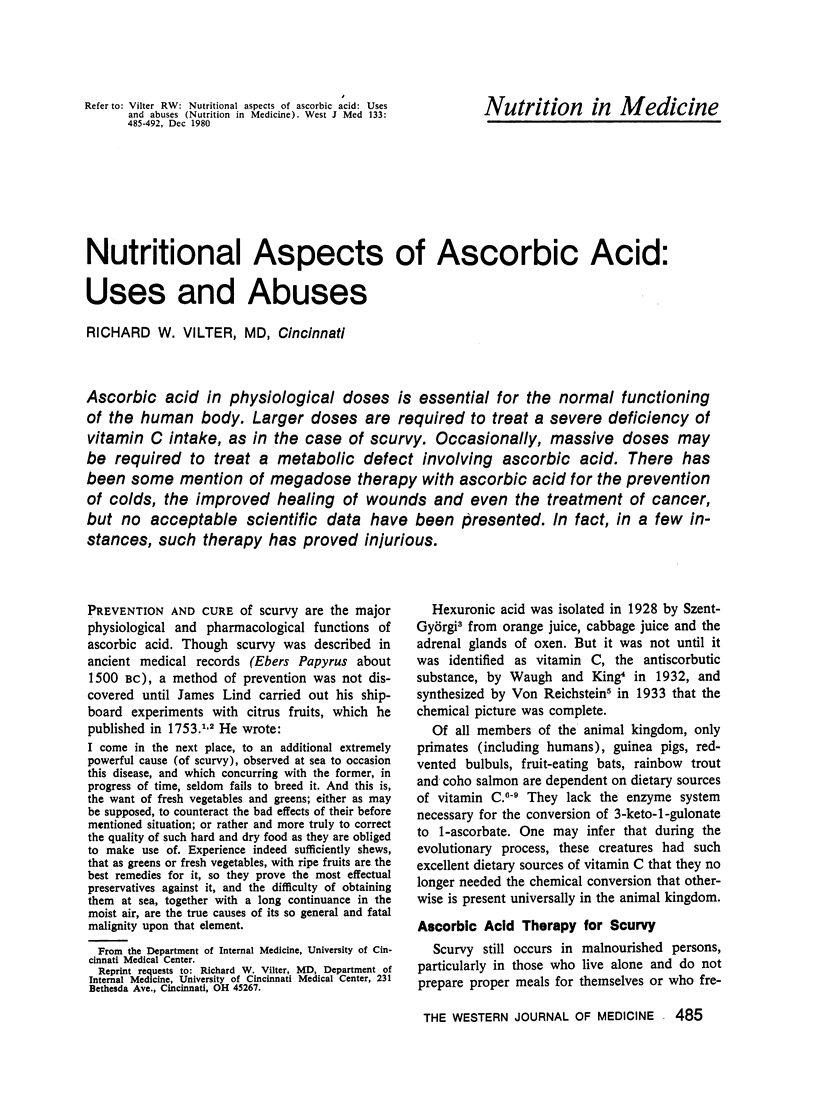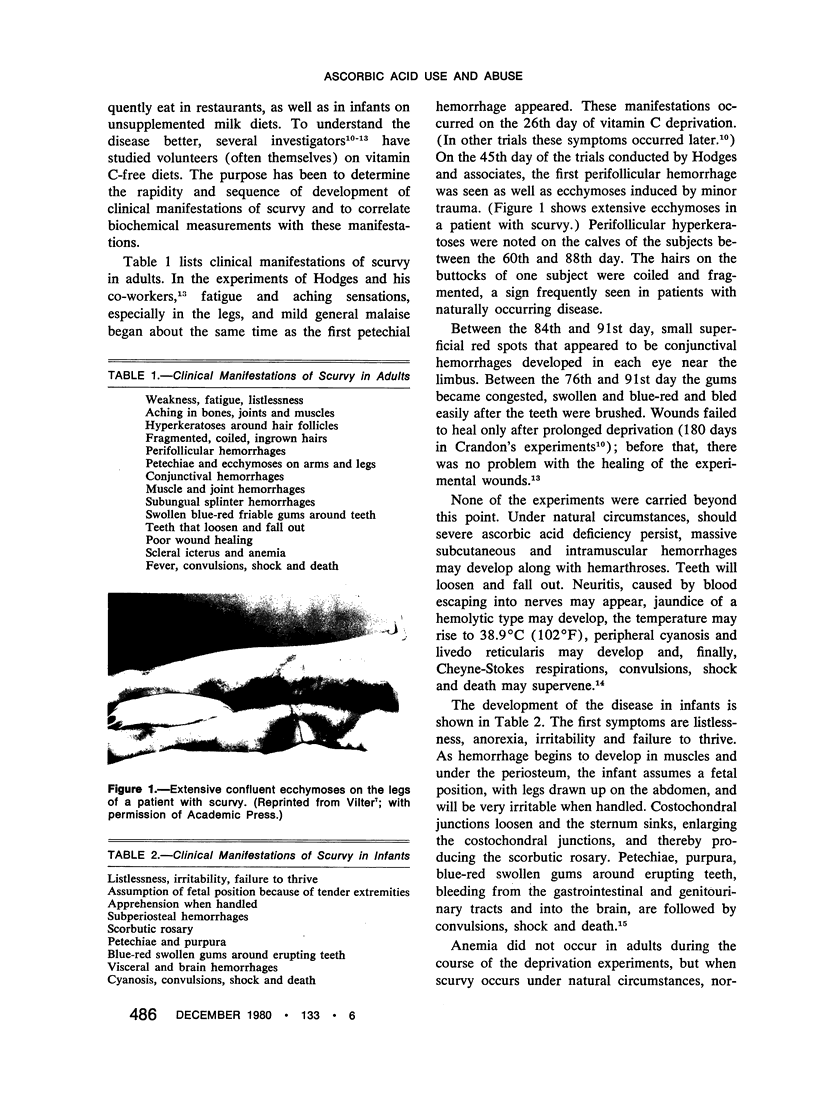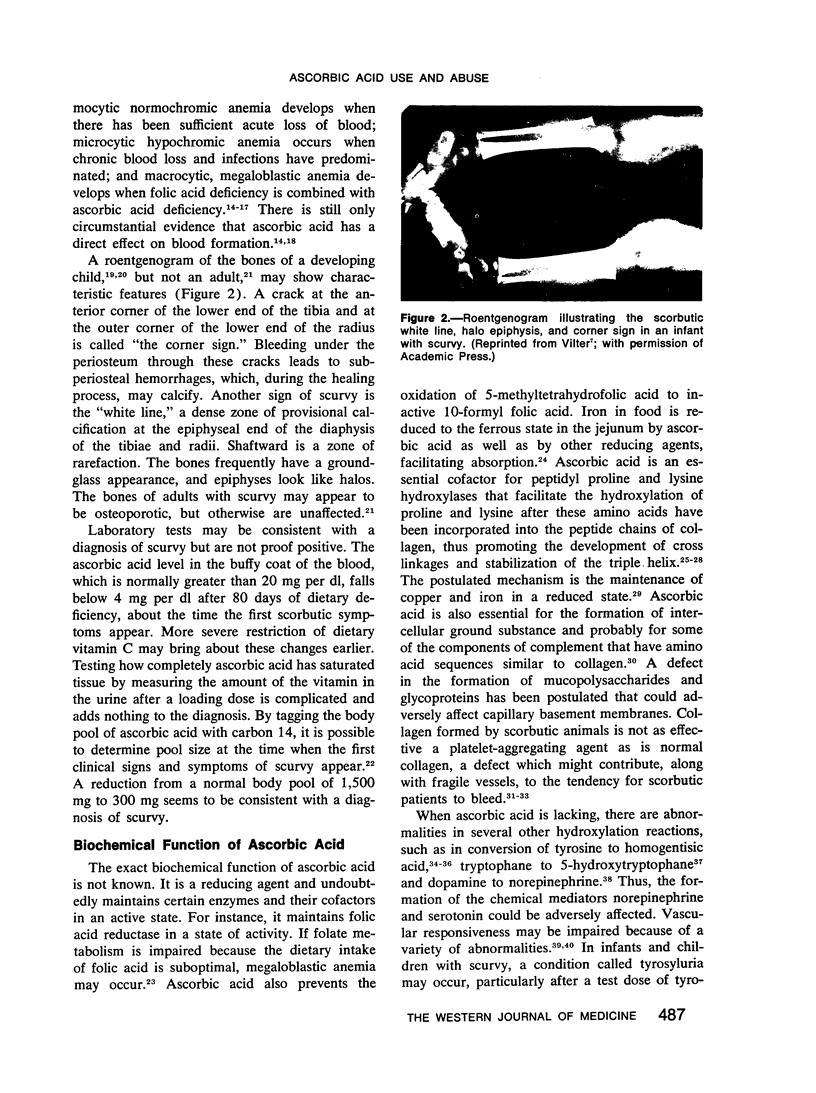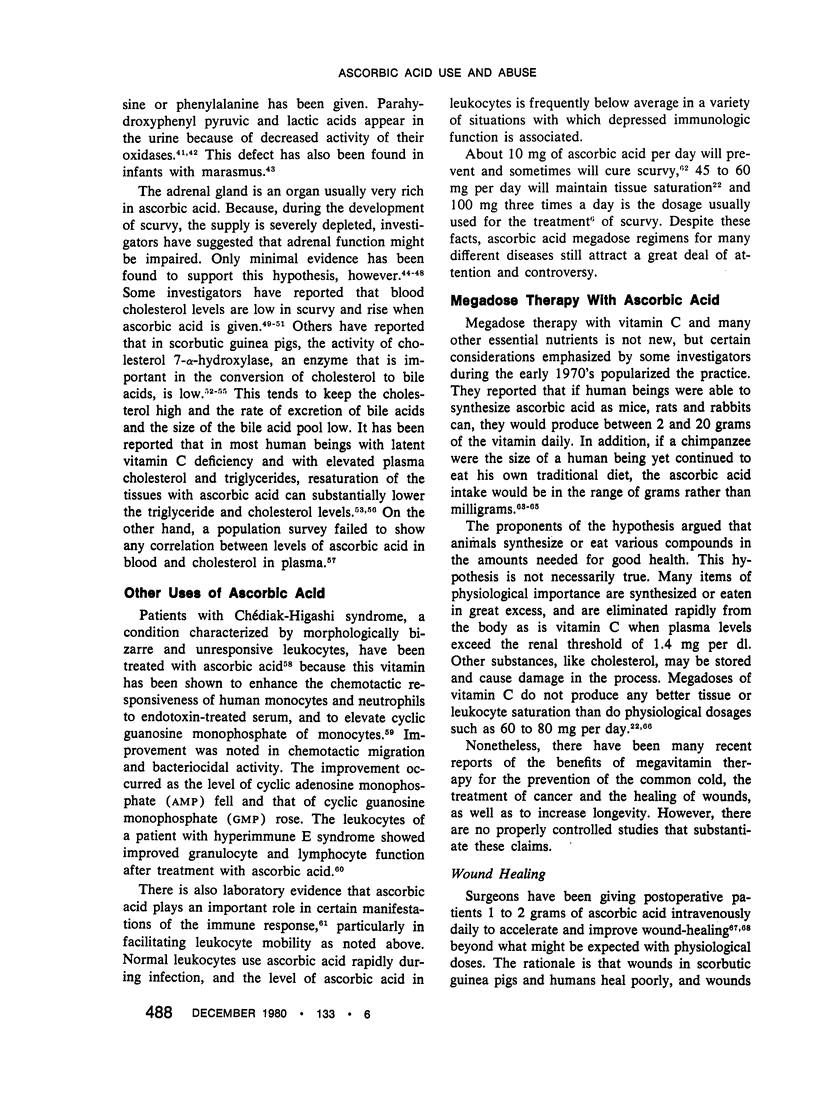Abstract
Ascorbic acid in physiological doses is essential for the normal functioning of the human body. Larger doses are required to treat a severe deficiency of vitamin C intake, as in the case of scurvy. Occasionally, massive doses may be required to treat a metabolic defect involving ascorbic acid. There has been some mention of megadose therapy with ascorbic acid for the prevention of colds, the improved healing of wounds and even the treatment of cancer, but no acceptable scientific data have been presented. In fact, in a few instances, such therapy has proved injurious.
Full text
PDF







Images in this article
Selected References
These references are in PubMed. This may not be the complete list of references from this article.
- Abboud F. M., Hood J., Hodges R. E., Mayer H. E. Autonomic reflexes and vascular reactivity in experimental scurvy in man. J Clin Invest. 1970 Feb;49(2):298–307. doi: 10.1172/JCI106239. [DOI] [PMC free article] [PubMed] [Google Scholar]
- BRONTE-STEWART B., ROBERTS B., WELLS V. M. Serum cholesterol in vitamin C deficiency in man. Br J Nutr. 1963;17:61–68. doi: 10.1079/bjn19630007. [DOI] [PubMed] [Google Scholar]
- BRONTE-STEWART B. The anaemia of adult scurvy. Q J Med. 1953 Jul;22(87):309–329. [PubMed] [Google Scholar]
- Baird I. M., Hughes R. E., Wilson H. K., Davies J. E., Howard A. N. The effects of ascorbic acid and flavonoids on the occurrence of symptoms normally associated with the common cold. Am J Clin Nutr. 1979 Aug;32(8):1686–1690. doi: 10.1093/ajcn/32.8.1686. [DOI] [PubMed] [Google Scholar]
- Baker E. M., Hodges R. E., Hood J., Sauberlich H. E., March S. C. Metabolism of ascorbic-1-14C acid in experimental human scurvy. Am J Clin Nutr. 1969 May;22(5):549–558. doi: 10.1093/ajcn/22.5.549. [DOI] [PubMed] [Google Scholar]
- Barnes M. J., Constable B. J., Kodicek E. Studies in vivo on the biosynthesis of collagen and elastin in ascorbic acid-deficient guinea pigs. Biochem J. 1969 Jun;113(2):387–397. doi: 10.1042/bj1130387. [DOI] [PMC free article] [PubMed] [Google Scholar]
- Barnes M. J., Kodicek E. Biological hydroxylations and ascorbic acid with special regard to collagen metabolism. Vitam Horm. 1972;30:1–43. doi: 10.1016/s0083-6729(08)60793-1. [DOI] [PubMed] [Google Scholar]
- Barness L. A. Safety considerations with high ascorbic acid dosage. Ann N Y Acad Sci. 1975 Sep 30;258:523–528. doi: 10.1111/j.1749-6632.1975.tb29311.x. [DOI] [PubMed] [Google Scholar]
- Berry W. T., Darke S. J. Vitamins in health and disease. Practitioner. 1968 Aug;201(202):305–313. [PubMed] [Google Scholar]
- Björkhem I., Kallner A., Karlmar K. E. Effects of ascorbic acid deficiency on adrenal mitochondrial hydroxylations in guinea pigs. J Lipid Res. 1978 Aug;19(6):695–704. [PubMed] [Google Scholar]
- Boxer L. A., Watanabe A. M., Rister M., Besch H. R., Jr, Allen J., Baehner R. L. Correction of leukocyte function in Chediak-Higashi syndrome by ascorbate. N Engl J Med. 1976 Nov 4;295(19):1041–1045. doi: 10.1056/NEJM197611042951904. [DOI] [PubMed] [Google Scholar]
- Briggs M. Letter: Vitamin-C-induced hyperoxaluria. Lancet. 1976 Jan 17;1(7951):154–154. doi: 10.1016/s0140-6736(76)93207-4. [DOI] [PubMed] [Google Scholar]
- COON W. W. Ascorbic acid metabolism in postoperative patients. Surg Gynecol Obstet. 1962 May;114:522–534. [PubMed] [Google Scholar]
- CRANDON J. H., LENNIHAN R., Jr, MIKAL S., REIF A. E. Ascorbic acid economy in surgical patients. Ann N Y Acad Sci. 1961 Apr 21;92:246–267. doi: 10.1111/j.1749-6632.1961.tb46124.x. [DOI] [PubMed] [Google Scholar]
- Caen J. P., Legrand Y. Abnormalities in the platelet-collagen reaction. Ann N Y Acad Sci. 1972 Oct 27;201:194–204. doi: 10.1111/j.1749-6632.1972.tb16299.x. [DOI] [PubMed] [Google Scholar]
- Cameron E., Pauling L., Leibovitz B. Ascorbic acid and cancer: a review. Cancer Res. 1979 Mar;39(3):663–681. [PubMed] [Google Scholar]
- Cameron E., Pauling L. Supplemental ascorbate in the supportive treatment of cancer: Prolongation of survival times in terminal human cancer. Proc Natl Acad Sci U S A. 1976 Oct;73(10):3685–3689. doi: 10.1073/pnas.73.10.3685. [DOI] [PMC free article] [PubMed] [Google Scholar]
- Campbell G. D., Jr, Steinberg M. H., Bower J. D. Letter: Ascorbic acid-induced hemolysis in G-6-PD deficiency. Ann Intern Med. 1975 Jun;82(6):810–810. doi: 10.7326/0003-4819-82-6-810_1. [DOI] [PubMed] [Google Scholar]
- Chalmers T. C. Effects of ascorbic acid on the common cold. An evaluation of the evidence. Am J Med. 1975 Apr;58(4):532–536. doi: 10.1016/0002-9343(75)90127-8. [DOI] [PubMed] [Google Scholar]
- Cochrane W. A. Overnutrition in prenatal and neonatal life: a problem? Can Med Assoc J. 1965 Oct 23;93(17):893–899. [PMC free article] [PubMed] [Google Scholar]
- Coulehan J. L. Ascorbic acid and the common cold: reviewing the evidence. Postgrad Med. 1979 Sep;66(3):153-5, 157-8, 160. doi: 10.1080/00325481.1979.11715253. [DOI] [PubMed] [Google Scholar]
- Cox E. V., Meynell M. J., Northam B. E., Cooke W. T. The anaemia of scurvy. Am J Med. 1967 Feb;42(2):220–227. doi: 10.1016/0002-9343(67)90021-6. [DOI] [PubMed] [Google Scholar]
- Creagan E. T., Moertel C. G., O'Fallon J. R., Schutt A. J., O'Connell M. J., Rubin J., Frytak S. Failure of high-dose vitamin C (ascorbic acid) therapy to benefit patients with advanced cancer. A controlled trial. N Engl J Med. 1979 Sep 27;301(13):687–690. doi: 10.1056/NEJM197909273011303. [DOI] [PubMed] [Google Scholar]
- Dhatt P. S., Saini A. S., Gupta I., Mehta H. C., Singh H. Tyrosyluria in marasmus. Br J Nutr. 1979 Nov;42(3):387–390. doi: 10.1079/bjn19790128. [DOI] [PubMed] [Google Scholar]
- Dubin B., MacLennan W. J., Hamilton J. C. Adrenal function and ascorbic acid concentrations in elderly women. Gerontology. 1978;24(6):473–476. doi: 10.1159/000212287. [DOI] [PubMed] [Google Scholar]
- Dykes M. H., Meier P. Ascorbic acid and the common cold. Evaluation of its efficacy and toxicity. JAMA. 1975 Mar 10;231(10):1073–1079. [PubMed] [Google Scholar]
- Elsas L. J., 2nd, Miller R. L., Pinnell S. R. Inherited human collagen lysyl hydroxylase deficiency: ascorbic acid response. J Pediatr. 1978 Mar;92(3):378–384. doi: 10.1016/s0022-3476(78)80423-5. [DOI] [PubMed] [Google Scholar]
- Elwood P. C., Hughes R. E., Hurley R. J. Ascorbic acid and serum-cholesterol. Lancet. 1970 Dec 5;2(7684):1197–1197. doi: 10.1016/s0140-6736(70)90390-9. [DOI] [PubMed] [Google Scholar]
- Friedenberg W. R., Marx J. J., Jr, Hansen R. L., Haselby R. C. Hyperimmunoglobulin E syndrome: response to transfer factor and ascorbic acid therapy. Clin Immunol Immunopathol. 1979 Feb;12(2):132–142. doi: 10.1016/0090-1229(79)90002-3. [DOI] [PubMed] [Google Scholar]
- GROLLMAN A. P., LEHNINGER A. L. Enzymic synthesis of L-ascorbic acid in different animal species. Arch Biochem Biophys. 1957 Jul;69:458–467. doi: 10.1016/0003-9861(57)90510-6. [DOI] [PubMed] [Google Scholar]
- Ginter E. Letter: Vitamin C and plasma lipids. N Engl J Med. 1976 Mar 4;294(10):559–560. doi: 10.1056/NEJM197603042941025. [DOI] [PubMed] [Google Scholar]
- Graziano J. H., Cerami A. Chelation therapy for the treatment of thalassemia. Semin Hematol. 1977 Jan;14(1):127–134. [PubMed] [Google Scholar]
- Hankes L. V. Letter: Interrelationships of ascorbic acid and tryptophan metabolism. Am J Clin Nutr. 1974 Aug;27(8):770–771. doi: 10.1093/ajcn/27.8.770. [DOI] [PubMed] [Google Scholar]
- Harris W. S., Kottke B. A., Subbiah M. T. Bile acid metabolism in ascorbic acid-deficient guinea pigs. Am J Clin Nutr. 1979 Sep;32(9):1837–1841. doi: 10.1093/ajcn/32.9.1837. [DOI] [PubMed] [Google Scholar]
- Herbert V., Jacob E. Destruction of vitamin B12 by ascorbic acid. JAMA. 1974 Oct 14;230(2):241–242. [PubMed] [Google Scholar]
- Herbert V., Jacob E., Wong K. T., Scott J., Pfeffer R. D. Low serum vitamin B12 levels in patients receiving ascorbic acid in megadoses: studies concerning the effect of ascorbate on radioisotope vitamin B12 assay. Am J Clin Nutr. 1978 Feb;31(2):253–258. doi: 10.1093/ajcn/31.2.253. [DOI] [PubMed] [Google Scholar]
- Hines J. D. Letter: Ascorbic acid and vitamin B12 deficiency. JAMA. 1975 Oct 6;234(1):24–24. [PubMed] [Google Scholar]
- Hodges R. E., Baker E. M., Hood J., Sauberlich H. E., March S. C. Experimental scurvy in man. Am J Clin Nutr. 1969 May;22(5):535–548. doi: 10.1093/ajcn/22.5.535. [DOI] [PubMed] [Google Scholar]
- Hodges R. E., Baker E. M., Hood J., Sauberlich H. E., March S. C. Experimental scurvy in man. Am J Clin Nutr. 1969 May;22(5):535–548. doi: 10.1093/ajcn/22.5.535. [DOI] [PubMed] [Google Scholar]
- Hodges R. E., Hood J., Canham J. E., Sauberlich H. E., Baker E. M. Clinical manifestations of ascorbic acid deficiency in man. Am J Clin Nutr. 1971 Apr;24(4):432–443. doi: 10.1093/ajcn/24.4.432. [DOI] [PubMed] [Google Scholar]
- Hughes R. E. Nonscorbutic effects of vitamin C: biochemical aspects. Proc R Soc Med. 1977 Feb;70(2):86–89. [PMC free article] [PubMed] [Google Scholar]
- Irvin T. T., Chattopadhyay D. K., Smythe A. Ascorbic acid requirements in postoperative patients. Surg Gynecol Obstet. 1978 Jul;147(1):49–55. [PubMed] [Google Scholar]
- JOFFE N. Some radiological aspects of scurvy in the adult. Br J Radiol. 1961 Jul;34:429–437. doi: 10.1259/0007-1285-34-403-429. [DOI] [PubMed] [Google Scholar]
- Karlowski T. R., Chalmers T. C., Frenkel L. D., Kapikian A. Z., Lewis T. L., Lynch J. M. Ascorbic acid for the common cold. A prophylactic and therapeutic trial. JAMA. 1975 Mar 10;231(10):1038–1042. [PubMed] [Google Scholar]
- Kirchheiner B. The influence of ascorbic acid deficiency on connective tissues. Dan Med Bull. 1969 Mar;16(3):73–76. [PubMed] [Google Scholar]
- Kitabchi A. E., Duckworth W. C. Pituitary adrenal axis evaluation in human scurvy. Am J Clin Nutr. 1970 Aug;23(8):1012–1014. doi: 10.1093/ajcn/23.8.1012. [DOI] [PubMed] [Google Scholar]
- Krumdieck C., Butterworth C. E., Jr Ascorbate--cholesterol--lecithin interactions: factors of potential importance in the pathogenesis of atherosclerosis. Am J Clin Nutr. 1974 Aug;27(8):866–876. doi: 10.1093/ajcn/27.8.866. [DOI] [PubMed] [Google Scholar]
- LEE R. E. Ascorbic acid and the peripheral vascular system. Ann N Y Acad Sci. 1961 Apr 21;92:295–301. doi: 10.1111/j.1749-6632.1961.tb46129.x. [DOI] [PubMed] [Google Scholar]
- LEVENSON S. M., UPJOHN H. L., PRESTON J. A., STEER A. Effect of thermal burns on wound healing. Ann Surg. 1957 Sep;146(3):357–368. [PMC free article] [PubMed] [Google Scholar]
- Levine S. Z., Marples E., Gordon H. H. A DEFECT IN THE METABOLISM OF TYROSINE AND PHENYLALANINE IN PREMATURE INFANTS. I. IDENTIFICATION AND ASSAY OF INTERMEDIARY PRODUCTS. J Clin Invest. 1941 Mar;20(2):199–207. doi: 10.1172/JCI101212. [DOI] [PMC free article] [PubMed] [Google Scholar]
- MCCANN P. The incidence and value of radiological signs in scurvy. Br J Radiol. 1962 Oct;35:683–686. doi: 10.1259/0007-1285-35-418-683. [DOI] [PubMed] [Google Scholar]
- MOORE C. V., DUBACH R. Observations on the absorption of iron from foods tagged with radioiron. Trans Assoc Am Physicians. 1951;64:245–256. [PubMed] [Google Scholar]
- McNicol G. P., Douglas A. S. Platelet abnormality in human scurvy. Lancet. 1967 May 6;1(7497):975–978. [PubMed] [Google Scholar]
- Mengel C. E., Greene H. L., Jr Letter: Ascorbic acid effects on erythrocytes. Ann Intern Med. 1976 Apr;84(4):490–490. doi: 10.7326/0003-4819-84-4-490_1. [DOI] [PubMed] [Google Scholar]
- Miller J. Z., Nance W. E., Norton J. A., Wolen R. L., Griffith R. S., Rose R. J. Therapeutic effect of vitamin C. A co-twin control study. JAMA. 1977 Jan 17;237(3):248–251. [PubMed] [Google Scholar]
- Moran J. R., Greene H. L. The B vitamins and vitamin C in human nutrition. II. 'Conditional' B vitamins and vitamin C. Am J Dis Child. 1979 Mar;133(3):308–314. doi: 10.1001/archpedi.1979.02130030084016. [DOI] [PubMed] [Google Scholar]
- Morin R. J. Arterial cholesterol and vitamin C. Lancet. 1972 Mar 11;1(7750):594–595. doi: 10.1016/s0140-6736(72)90390-x. [DOI] [PubMed] [Google Scholar]
- Murphy F. J., Zelman S. Ascorbic acid as a urinary acidifying agent. 1. Comparison with the ketogenic effect of fasting. J Urol. 1965 Sep;94(3):297–299. doi: 10.1016/S0022-5347(17)63619-X. [DOI] [PubMed] [Google Scholar]
- Murphy F. J., Zelman S., Mau W. Ascorbic acid as a urinary acidifying agent. 2. Its adjunctive role in chronic urinary infection. J Urol. 1965 Sep;94(3):300–303. doi: 10.1016/S0022-5347(17)63620-6. [DOI] [PubMed] [Google Scholar]
- PIRANI C. L. Review: relation of vitamin C to adrenocortical function and stress phenomena. Metabolism. 1952 May;1(3):197–222. [PubMed] [Google Scholar]
- Pauling L. Are recommended daily allowances for vitamin C adequate? Proc Natl Acad Sci U S A. 1974 Nov;71(11):4442–4446. doi: 10.1073/pnas.71.11.4442. [DOI] [PMC free article] [PubMed] [Google Scholar]
- Pauling L. Evolution and the need for ascorbic acid. Proc Natl Acad Sci U S A. 1970 Dec;67(4):1643–1648. doi: 10.1073/pnas.67.4.1643. [DOI] [PMC free article] [PubMed] [Google Scholar]
- Pitt H. A., Costrini A. M. Vitamin C prophylaxis in marine recruits. JAMA. 1979 Mar 2;241(9):908–911. [PubMed] [Google Scholar]
- ROGERS K. B., KOEGLER S. J., GERRARD J. Chloramphenicol in treatment of infantile gastroenteritis; a preliminary report. Br Med J. 1949 Dec 31;2(4643):1501–1504. doi: 10.1136/bmj.2.4643.1501. [DOI] [PMC free article] [PubMed] [Google Scholar]
- Rokosova B., Chvapil M. Relationship between the dose of ascorbic acid and its structural analogs and proline hydroxylation in various biological systems. Connect Tissue Res. 1974;2(3):215–221. doi: 10.3109/03008207409152246. [DOI] [PubMed] [Google Scholar]
- SEALOCK R. R., GOODLAND R. L., SUMERWELL W. N., BRIERLY J. M. The role of ascorbic acid in the oxidation of L-Tyrosine by guinea pig liver extracts. J Biol Chem. 1952 May;196(2):761–767. [PubMed] [Google Scholar]
- Sandler J. A., Gallin J. I., Vaughan M. Effects of serotonin, carbamylcholine, and ascorbic acid on leukocyte cyclic GMP and chemotaxis. J Cell Biol. 1975 Nov;67(2PT1):480–484. doi: 10.1083/jcb.67.2.480. [DOI] [PMC free article] [PubMed] [Google Scholar]
- Sato P., Udenfriend S. Studies on ascorbic acid related to the genetic basis of scurvy. Vitam Horm. 1978;36:33–52. doi: 10.1016/s0083-6729(08)60981-4. [DOI] [PubMed] [Google Scholar]
- Schrauzer G. N., Rhead W. J. Ascorbic acid abuse: effects on long term ingestion of excessive amounts on blood levels and urinary excretion. Int J Vitam Nutr Res. 1973;43(2):201–211. [PubMed] [Google Scholar]
- Stein H. B., Hasan A., Fox I. H. Ascorbic acid-induced uricosuria. A consequency of megavitamin therapy. Ann Intern Med. 1976 Apr;84(4):385–388. doi: 10.7326/0003-4819-84-4-385. [DOI] [PubMed] [Google Scholar]
- Stokes P. L., Melikian V., Leeming R. L., Portman-Graham H., Blair J. A., Cooke W. T. Folate metabolism in scurvy. Am J Clin Nutr. 1975 Feb;28(2):126–129. doi: 10.1093/ajcn/28.2.126. [DOI] [PubMed] [Google Scholar]
- Svirbely J. L., Szent-Györgyi A. The chemical nature of vitamin C. Biochem J. 1932;26(3):865–870. doi: 10.1042/bj0260865. [DOI] [PMC free article] [PubMed] [Google Scholar]
- TREAGER H. S., GABUZDA G. J., ZAMCHECK N., DAVIDSON C. S. Response to adrenocorticotrophic hormone in clinical scurvy. Proc Soc Exp Biol Med. 1950 Nov;75(2):517–520. doi: 10.3181/00379727-75-18250. [DOI] [PubMed] [Google Scholar]
- Thomas W. R., Holt P. G. Vitamin C and immunity: an assessment of the evidence. Clin Exp Immunol. 1978 May;32(2):370–379. [PMC free article] [PubMed] [Google Scholar]
- WOODRUFF C. Infantile scurvy; the increasing incidence of scurvy in the Nashville area. J Am Med Assoc. 1956 Jun 2;161(5):448–456. doi: 10.1001/jama.1956.62970050015011. [DOI] [PubMed] [Google Scholar]
- Zuskin E., Lewis A. J., Bouhuys A. Inhibition of histamine-induced airway constriction by ascorbic acid. J Allergy Clin Immunol. 1973 Apr;51(4):218–226. doi: 10.1016/0091-6749(73)90141-3. [DOI] [PubMed] [Google Scholar]




